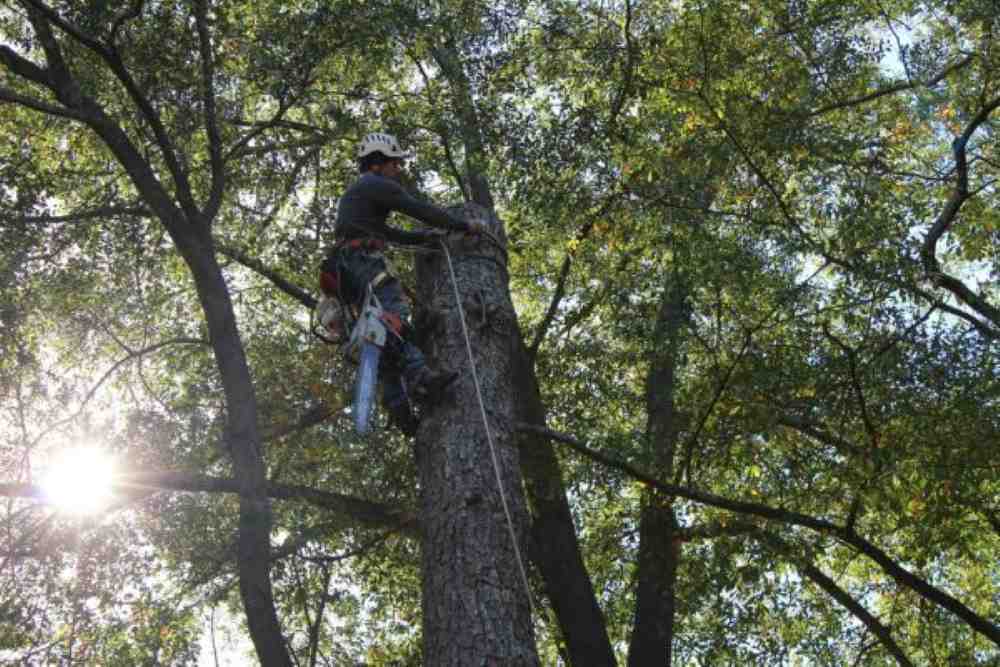Tree service are professional solutions aimed at maintaining, improving, or removing trees in residential, commercial, or public spaces. From trimming to complete removal, these services help trees thrive or eliminate them when they become dangerous.
Why Tree Services Matter
Trees add value, beauty, and shade to properties, but they also require attention. Neglect can lead to dead limbs, dangerous falls, or even legal issues. Professional tree care keeps your green assets healthy and your property safe.
Types of Tree Services
Tree Removal
When a tree becomes hazardous due to disease, damage, or proximity to structures, removal is necessary. This involves safely cutting it down and clearing the area.
Tree Pruning and Trimming
Regular trimming helps trees grow properly, prevents limb breakage, and improves appearance. It’s also key to maintaining safety and sunlight access.
Stump Grinding and Removal
Leftover stumps are unsightly, attract pests, and get in the way. Grinding or removal ensures a clean yard and safer space.
Tree Planting
Adding trees to your landscape? Pros know which species thrive in your area and how to plant them for long-term success.
Emergency Tree Services
Storm damage or sudden falls require fast action. Emergency services handle urgent removals to prevent further damage or injury.
Tree Health Inspections
Certified arborists examine your trees for pests, disease, and structural integrity—keeping them healthy before issues escalate.
Benefits of Professional Tree Services
Ensures Tree Health
Experts understand what your trees need and can identify problems early, promoting longevity.
Improves Property Aesthetics
A well-trimmed tree makes your property look clean, welcoming, and well-kept.
Enhances Safety
Weak limbs or overgrown branches can fall and cause serious damage. Regular maintenance prevents hazards.
Saves Time and Money
Trying to do it yourself? That chainsaw may cost more in damage than you expect. Professionals get it right the first time.
Signs You Need Tree Services
Dead or Dying Trees
If a tree isn’t blooming or has discolored leaves and brittle bark, it might be dying.
Overgrown Branches
Branches scraping your roof or power lines are a big red flag.
Trees Too Close to Structures
Roots can crack foundations or pavements, while branches may damage roofs and windows.
Signs of Pests or Disease
Holes in bark, fungus growth, or oozing sap may mean your tree is under attack.
Tree Pruning Explained
When to Prune Trees
Late winter or early spring is ideal, but it depends on the species and location.
Techniques Used by Arborists
- Crown thinning
- Deadwooding
- Crown raising
- Reduction
Benefits of Regular Pruning
It enhances air circulation, sunlight exposure, and keeps your trees structurally sound.
Tree Removal Services
When Tree Removal is Necessary
- Tree is dead or dying
- Dangerous lean
- Root damage to structures
- Obstructing construction
Safe and Efficient Removal Process
Experts use ropes, cranes, and cutting techniques to prevent damage and injuries.
Emergency Tree Services
What Qualifies as an Emergency?
- Tree fallen on a house
- Blocked driveways
- Risk of falling due to weather or disease
Immediate Steps to Take
- Keep people and pets away
- Call emergency tree services
- Document damage for insurance
Stump Grinding and Removal
Why Remove a Stump?
Stumps rot over time, become trip hazards, and attract pests like termites.
Grinding vs. Full Removal
- Grinding: Quick and leaves roots
- Full Removal: Removes stump and roots, better for replanting
Tree Planting and Planning
Choosing the Right Tree
Consider climate, soil type, and sunlight. Native trees are often best.
Proper Planting Techniques
- Dig wide, not deep
- Mulch properly
- Water consistently
Tree Health Assessments
What Arborists Look For
- Signs of rot
- Insect infestations
- Structural damage
Tools and Techniques Used
- Resistograph testing
- Boring tools
- Visual inspections
Seasonal Tree Care Tips
Spring and Summer
- Fertilize and water
- Check for pests
- Light pruning
Fall and Winter
- Heavy pruning
- Mulch for insulation
- Remove dead limbs before snow
How to Choose the Right Tree Service Company
Credentials to Look For
- Certified arborists
- Insurance and bonding
- Positive reviews
Questions to Ask
- What’s your experience?
- Do you offer emergency services?
- Can you provide a quote upfront?
Tree Service Costs
What Affects the Price
- Tree size
- Location and access
- Type of service
- Urgency
Average Cost Breakdown
- Pruning: $100–$500
- Removal: $300–$2,000
- Stump grinding: $75–$400
DIY Tree Care vs. Hiring a Pro
Risks of DIY
Ladders, chainsaws, and heavy limbs can lead to injuries and damage.
When to Call the Experts
If the tree is large, near power lines, or requires climbing—call in the pros.
Conclusion and Takeaways
Tree services are more than just cutting and clearing. They’re about preserving beauty, ensuring safety, and investing in your property’s future. Whether it’s routine pruning, a tree emergency, or planting new greenery, expert help ensures your trees get the care they deserve. Don’t wait for disaster—maintain your trees today for a greener, safer tomorrow.
FAQs
1. How often should I trim my trees?
Every 1–3 years, depending on the species and growth rate.
2. Is it cheaper to remove a tree myself?
Upfront, maybe—but the risk of injury or damage makes it more costly in the long run.
3. What’s the best time of year for tree removal?
Winter is ideal since trees are dormant, but emergency removals can happen anytime.
4. Can trees recover from disease?
Yes, with early diagnosis and proper treatment, many trees can bounce back.
5. Are tree services covered by insurance?
Usually only if the tree causes damage—check with your provider for details.

